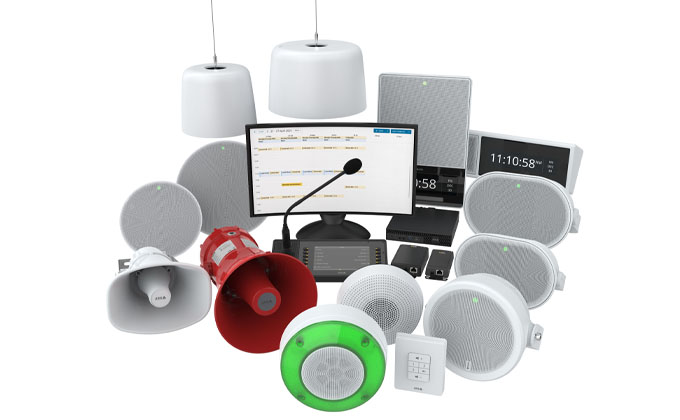Axis Communications: The Power of Network Audio in Public Address Systems

The move from analog speakers to network-based digital systems has been transformative. Providing crystal clear audio, critical safety functions, integration with third parties, and automated workflows, modern public address systems are saving lives, money, and time.
IP-based digital audio is a game changer. It is improving safety and security, how we teach, and how we deliver care. It caters to different needs and abilities, supporting patients, customers, students, and staff alike. And it works with other systems, speeding up processes and response times. How? By being part of the network.
Network-based audio is truly part of a site’s infrastructure. It effectively becomes a series of IP-based IoT devices. This unlocks a whole host of potential benefits and capabilities. Which is why public address (PA) systems are going digital.
Precise Audio Delivery
The first goal of any PA system is to get the right messages heard by the right people. This requires targeted messages that are clear and audible. As well as providing high-quality audio, with less distortion, and more precise sound controls (particularly useful for high ambient noise areas), network-based audio enables powerful device management features and functions.
Flexible Zones, Content, and Message Scheduling
Creating audio zones allows specific content – scheduled or live – to be played across one or more of them. For example, schools can make zones for each classroom while also having school-wide announcements, bells, or alarms. This way teachers can be mic’d up to better support students with attention issues, learning difficulties, or hearing issues.
Digital PA installations can be easily divided into zones independently of physical cabling, making their administration simple and easy to change. This means no need for re-cabling, no downtime, and no need to send staff to physically visit the site. If you want to expand or modify your system in any way, it’s easy to do. Devices are simply plugged in via power over ethernet (PoE) switches. You then add the speakers to the desired zones or move speakers around via the software remotely.
Two-Way Audio Communication
Another benefit of digital audio is two-way audio. As Axis speakers come with built-in microphones, they can both pick up and broadcast sound. Combined with zoning, they allow for precise two-way communication.
Device Health Monitoring
To maintain the quality and reliability of your PA system, it’s important to monitor the health of devices and their audio output. Both of these diagnostics can be carried out remotely over the network. By sending a tone through the speakers, the onboard microphone can check the device and audio health. These actions can be scheduled automatically or carried out manually. This saves time compared to many analog audio devices that need to be manually tested by visiting each speaker individually.
Complementing Your Video Surveillance System
As digital devices, IP-based speakers have native computing capabilities, bringing intelligence to the edge. You no longer need racks of gear to manage devices, separately store pre-recorded messages, or manage input/outputs (I/Os) for automated workflows. Everything is connected via PoE to your main network.
This makes networked public address systems a natural extension to any existing IP-based surveillance and security network. Bringing audio devices onto the same network allows all of the devices – cameras, lights, radars, access controls, speakers, intercoms, and beyond – to work together, unlocking a variety of powerful integration capabilities, such as automated reactive and proactive messages and warnings.
Automated Messages and Warnings
Axis security cameras have onboard video analytics capabilities. Video analytics can be trained to identify all manners of behaviors and scenarios, from someone misusing or blocking an emergency exit, propping open a fire door, or entering a restricted area, to monitoring retail checkout queue length or spotting people not wearing the correct personal protective equipment (PPE) for the area. In all of these instances, having a relevant audio notification automatically triggered is extremely useful, which is easily configurable thanks to device I/Os.
Likewise, AI-powered audio analytics can identify sounds such as screams, shouts, and breaking glass, automatically triggering notifications to relevant parties to investigate while PA systems confirm help is on its way.
Critical Communications
Axis PA systems can also support critical communications, providing the audio infrastructure and channels to broadcast alarms and communications. The first step to notifying people of any emergency is usually audio, typically a verbal announcement. While universal alarms may work for small sites, larger locations, such as school campuses, industrial sites, or across towns and cities, require you to be able to use zoning capabilities to reach everyone on site or just in specific areas to deliver the right messages.
But emergency communications don’t stop there. Public address systems need to support a range of capabilities to effectively safeguard the public, staff, and emergency response teams.
Mass Notification Systems and Third-Party Integration
Public address systems can only go so far when it comes to emergency response. They need to integrate with third-party emergency mass notification systems, like those from Singlewire, Alertus, or Lynx Systems. Certified mass notification systems take the concept of mass communication and public address a step further. They trigger all relevant devices on the network, such as laptops, pagers, digital signage, and mobile phones, sending intrusive messages to recipients, as well as reaching out to 911 emergency responders.
Because Axis devices, software, and hardware are all built on open standards, integration with existing systems and third-party solutions is straightforward.
Visual Triggers
Emergency notifications often have visual aid, such as a strobe or colored light. Modern speakers used for public address systems can be equipped with built-in light and even text capabilities, ensuring maximum comprehension.
AXIS D4200-VE Network Strobe Speaker, for example, features a ring of LEDs around its speaker. Different colors convey different meanings, supporting a range of automated audio messages. These LEDs are particularly useful when somebody has hearing difficulties or in extremely high ambient noise areas such as noisy cafeterias, bus stops, manufacturing plants, or construction sites.
In addition to playing announcements and activating strobes, both of which the new AXIS C1710 and C1720 Network Display Speakers are capable of, it also adds the ability to scroll characters across a display. This can be used to support third-party mass notification systems in critical situations informing occupants what to do in an emergency or used for basic information such as today’s lunch special or opening hours.
Finding a Reliable Partner
IP-based public address systems can greatly improve security, safety, and operational efficiency in public, institutional, and commercial premises. They’re the natural extension of any surveillance and security system and together drive powerful synergies. However, it’s important to find a partner you trust when investing in new systems.
Axis solutions adhere to the highest cybersecurity standards and certifications, including FIPS 140, working with both ADMX and ADM policy file types, and coming with secure boot features as standard. Our systems are also built on open standards, allowing for easy integration with existing networks and third-party solutions, helping future-proof your investment and providing a platform on which these systems can all work together.
So, if you’re looking to take advantage of network-based public address systems, ask your Axis systems integrator about our audio solutions today.
























